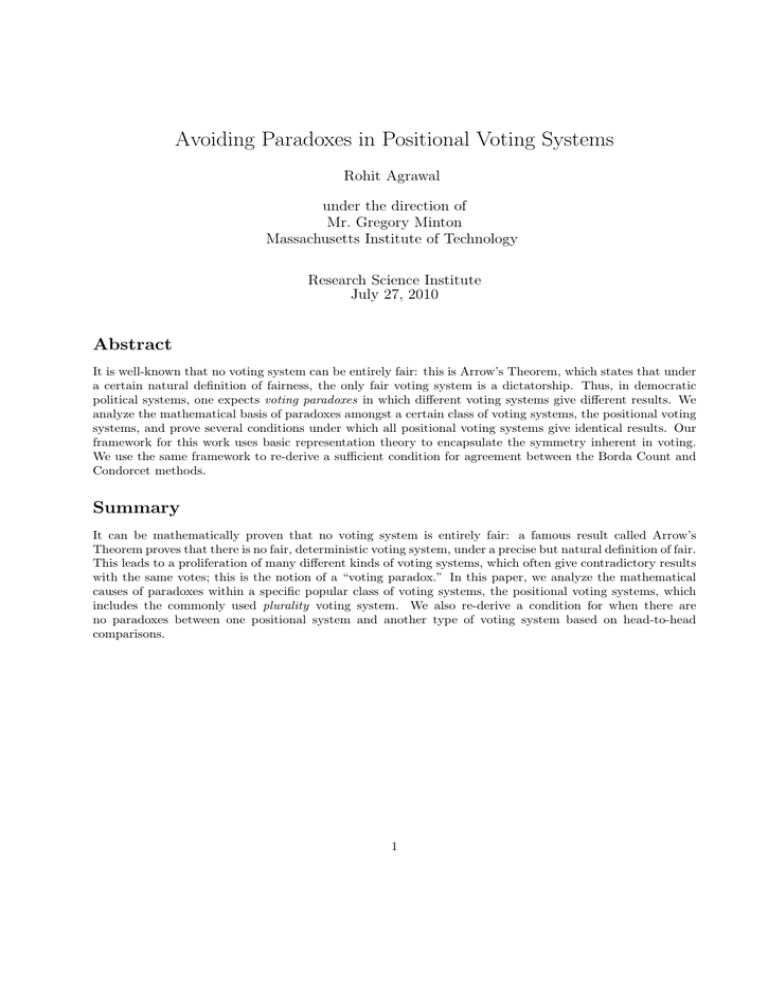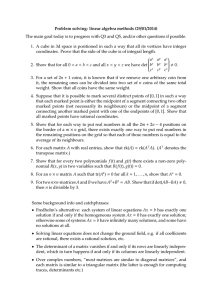Avoiding Paradoxes in Positional Voting Systems
advertisement

Avoiding Paradoxes in Positional Voting Systems Rohit Agrawal under the direction of Mr. Gregory Minton Massachusetts Institute of Technology Research Science Institute July 27, 2010 Abstract It is well-known that no voting system can be entirely fair: this is Arrow’s Theorem, which states that under a certain natural definition of fairness, the only fair voting system is a dictatorship. Thus, in democratic political systems, one expects voting paradoxes in which different voting systems give different results. We analyze the mathematical basis of paradoxes amongst a certain class of voting systems, the positional voting systems, and prove several conditions under which all positional voting systems give identical results. Our framework for this work uses basic representation theory to encapsulate the symmetry inherent in voting. We use the same framework to re-derive a sufficient condition for agreement between the Borda Count and Condorcet methods. Summary It can be mathematically proven that no voting system is entirely fair: a famous result called Arrow’s Theorem proves that there is no fair, deterministic voting system, under a precise but natural definition of fair. This leads to a proliferation of many different kinds of voting systems, which often give contradictory results with the same votes; this is the notion of a “voting paradox.” In this paper, we analyze the mathematical causes of paradoxes within a specific popular class of voting systems, the positional voting systems, which includes the commonly used plurality voting system. We also re-derive a condition for when there are no paradoxes between one positional system and another type of voting system based on head-to-head comparisons. 1 Expander Graphs, Eigenvalues, and Four-Cycles Wenyu Cao under the direction of Ms. Rosalie Bélanger-Rioux Massachusetts Institute of Technology Research Science Institute July 27, 2010 Abstract Expander graphs are extremely fascinating because not only do they exhibit strong connectivity properties but they also have relatively few edges. As regular expanders have already been exhaustively studied, we focus on generalizing results to biregular expanders. The relation between expander graphs, eigenvalues, and number of four-cycles is explored. We first give an algorithm that approximates the expansion of a graph. Results relating the number of four-cycles and eigenvalues of the adjacency matrix are obtained. Also, computer experimental results are provided to show the relationship between expansion and the number of four-cycles. Finally, we give a construction for an interesting class of four-cycle free Ramanujan graphs. Summary Expander graphs are extremely useful objects that have a variety of applications. Although expander graphs have relatively few edges, they are still highly connected. Much work has already been done regarding regular graphs as expanders and we seek to generalize these results to other graphs. We first present a fast algorithm that calculates a certain measure of expansion. We also establish a connection between a graph’s expansion and the number of cycles of length four in a graph. Finally, we construct a robust class of expanders that are void of four-cycles. 1 Orbits of Lower Triangular Matrices under Braid Group Transformations Aubrey Faust under the direction of Ms. Ailsa Keating Massachusetts Institute of Technology Research Science Institute July 27, 2010 Abstract We consider classes of lower triangular matrices with integer values and ones on the diagonal. These matrices give data about surfaces in a 4-dimensional space; a braid group acts on this space, and induces linear changes for the matrix. The majority of attention is devoted to the case of 3 × 3 matrices. We look at the orbits of matrices under the braid group operations, and prove that in all but five cases, orbits are infinite. We find a polynomial in the entries of the matrix that is invariant for any given orbit. We also consider the patterns of growth under the application of only one of the generators, and we find that the orbits exhibit a geometric-growth type behavior. Summary A braid of size 3 consists of three tangled pieces of string with all the end points fixed. There is a natural way to define an action of such a braid on a triplet of integers, outputting another triplet. Suppose you start with one triplet. What other ones can you get to? We found that for all but five classes of triplets, the answer is infinite set. We also study the rate of growth of the entries of a triple when one repeatedly applies a simple braid, and we find that it has a geometric-like beahvior. 1 Tropical Oriented Matroids and Subdivisions of Products of Simplices Christopher Guthrie under the direction of Mr. Kartik Venkatram Massachusetts Institute of Technology Research Science Institute July 27, 2010 Abstract We demonstrate partial results towards the conjectured bijection between tropical oriented matroids with (n, d)-types and subdivisions of the product of simplices ∆n−1 × ∆d−1 . We attempt to extend results from Ardila And Develin [?] showing that triangulations of ∆n−1 × ∆d−1 with d ≤ 3 or n ≤ 3 correspond to nondegenerate tropical oriented matroids to more general subdivisions formed by merging two adjacent full-dimensional cells. Summary We consider arrangements of tropical hyperplanes in a space of dimension d. A single hyperplane divides the space into d open regions, while a collection of hyperplanes divides the space into a more complicated collection of regions. Each point in space has an associated type given by specifying, for each hyperplane in the arrangement, which of the d regions of the space created by the hyperplane the point lies in. If we take the set of types given by all possible points in space, we get an object called a tropical oriented matroid. We also wish to characterize ways to subdivide certain multi-dimensional polyhedra, specifically products of two multi-dimensional triangles, into a number of smaller polyhedra. We encode each piece of a subdivision similarly to a type of a hyperplane arrangement. The collection of all of the types given by pieces of the subdivision is conjectured to give a tropical oriented matroid as well. For certain products, it has already been shown that any complete subdivision of the polyhedron yields a tropical oriented matroid. We attempt to extend these results to include any polyhedron obtained by combining two adjacent multi-dimensional triangles. 1 Enumerating Multiplicity-Free Labeled Floor Diagrams for Rational Curves Kevin Hu under the direction of Mr. John Lesieutre Massachusetts Institute of Technology Research Science Institute July 27, 2010 Abstract Labeled floor diagrams are weighted directed graphs with edges respecting vertex order such that the sum of the weights of all edges exiting each node is at most one more than the sum of the weights of all edges entering the node. Manipulation of the enumeration of these graphs counts algebraic curves in CP2 . In 2010, G. Mikhalkin and S. Fomin asked the question: how many multiplicity-free labeled floor diagrams of genus zero are there? In this paper, we use recursion and a new decomposition method to analyze specific cases of this problem and to find a general form for the number of such diagrams. Summary An interesting problem in mathematics is to count the number of surfaces with certain conditions. These surfaces can be transformed into corresponding graphs with certain characteristics, which are simpler to count. Thus, we explore an open problem that asks us to count a specific family of these graphs, and we deduce specific results as well as a general type of formula that would count the graphs. 1 Simple Connectedness of Some Flip Complexes Randy Jia under the direction of Mr. John Lesieutre Massachusettes Institute of Technology Research Science Institute July 27, 2010 Abstract A basic triangle is one that does not contain points in the interior or on the boundary, except for its vertices. We explore triangulations, or complete subdivisions of point sets into basic triangles. A flip in a triangulation replaces two triangles that form a quadrilateral with two different triangles that cover the same quadrilateral. The flip graph of the point set is a graph where vertices correspond to triangulations and edges correspond to flips. We transform the flip graph into a 2-complex by affixing square and pentagonal plates for some simple 4- and 5-cycles. We study simple connectedness of the flip complex and determine that all loops are built upon trivial cycles. Summary Given any finite set of points, we can connect points with nonintersecting lines. When no more points can be connected, one obtains a triangulation. Some of these triangulations are similar, and we construct a graph called the flip graph where vertices represent individual triangulations and edges connect similar triangulations. A path on this graph that starts with any vertex can move to other vertices and return to its starting vertex; this is called a loop in the graph. We look at whether there exist loops in this graph that are not just a combination of simple loops (in particular those of length four and five). We prove that all loops are based upon some combination of certain loops of length four and five. 1 A New Look at the Unknotting Question Matthew Kilgore under the direction of Ms. Ailsa Keating Massachusetts Institute of Technology Research Science Institute July 27, 2010 Abstract In this paper, we look at the unknotting question. We first present a probabilistic algorithm based on the work of Ivan Dynnikov for the unknotting problem; the algorithm runs in polynomial time. We then look at the accuracy of this algorithm; we find that it is highly precise when given knots of low complexity. The algorithm is then used to look at the distribution of unknots among random grid diagrams of complexity n. We conclude by examining the distribution of knots in general among random grid diagrams of complexity n. Summary In mathematics, a knot is a tangled string in which the ends have been joined. In this paper, we look at the problem of deciding whether or not a given knot can be untangled to a simple loop. We first present an algorithm for this problem. We next examine the efficiency—accuracy and speed—of this algorithm; we find that it is highly precise when given what we think of as a “small” knots. We continue by using the algorithm to look at the distribution of knots that can be untangled among randomly generated knots. We conclude by examining the distribution of knots in general among random diagrams which may include several knots. 1 Polynomial and 2-adic Analogues of the Collatz Problem Brian Kim under the direction of Mr. John Ullman Massachusetts Institute of Technology Research Science Institute July 27, 2010 Abstract We analyze analogues of the Collatz problem in two rings, the 2-adics and Zp [x]. We find the general form of a 2-adic integer that eventually reaches 1 after some finite number of iterations through the Collatz function. In addition, some interesting properties of the cycles in Zp [x] are shown. We find the orbit length and describe the behavior of the shortest cycle in this ring, and we express a cycling polynomial in general form. Finally, we describe the behavior of the constant polynomials in Zp [x]. Summary The Collatz problem, an unsolved problem in number theory, has many analogues, two of which are analyzed. The Collatz problem defines a function C(n) that equals 3n+1 if n is odd and n/2 if n is even. The conjecture states that for any positive integer n, if we iterate n through this function some finite number of times, we will reach 1. We look at the problems in the 2-adics, a ring that extends the rationals into a somewhat binary form, and we show that any polynomial that converges over the function must be of a certain form. It is proven that the Collatz problem in the 2-adics contains the original Collatz problem in the positive integers. We also look at a polynomial analogue of the problem, and we prove the existence and describe the behavior of a polynomial that reaches itself after exactly 2p iterations. It is shown that no other cycle can have shorter length. We find the general form of a cycling polynomial, and we describe the behavior of the constants over the Collatz function. 1 Entries of Random Matrices Benjamin Kraft under the direction of Mr. Gregory Minton Massachusetts Institute of Technology Research Science Institute July 27, 2010 Abstract Let Un be the group of n × n unitary matrices. To select a random unitary matrix, we use the Haar measure. Much study has been devoted to the eigenvalues of random unitary matrices, but little is known about the entries of random unitary matrices and their powers. In this work, we use eigenvalues to understand the entries of random unitary matrices and their powers. We characterize the exact distribution of the top-left entry in the case where the matrix is raised to a power at least n, and give some relationships for smaller powers. These results may have applications in quantum mechanics, telephone encryption, and statistical analysis, in addition to helping illuminate the field of random matrix theory. Summary In mathematics, a matrix is just a square grid of numbers. Matrices correspond to transformations in space, and we call a matrix orthogonal if it corresponds to a transformation which does not change the length or shape of objects it acts on. We call the corresponding type of matrix with complex entries unitary. Although there are infinitely many unitary matrices, there is a consistent method to select a random unitary matrix such that each matrix is equally likely to be selected. Much study has been devoted to the properties of random unitary matrices, but little is known about their actual entries and the entries of their powers. We determine the exact distributions of entries of higher powers of random unitary matrices. We also provide relations for the distributions of lower powers. These results have direct applications in quantum mechanics, as well as relations to telephone encryption and statistical analysis. 1 On Prime Factors of Fibonacci Numbers Styliani Pantela under the direction of Ms. Wang Lu Massachusetts Institute of Technology Research Science Institute July 27, 2010 Abstract Let Dv be the set of Fibonacci numbers that are not divisible by v. It is known that each prime divides infinitely many Fibonacci numbers. However, not all primes, excluding the trivial prime factors of v, divide the elements of Dv . Let Bv be the sequence that includes all numbers that divide no element of Dv such that all proper divisors of the elements of Bv divide some elements of Dv . Let f(v) denote the period of appearance of multiples of v in the Fibonacci sequence. It is known that 9 is the only composite number in B2 . We prove that 16 is the only composite in B3 . Moreover, we prove a general way to describe the composite and prime numbers in Bv for every number v, for which f(v) 6≡ 2 (mod 4). Summary Fibonacci numbers are the terms of the Fibonacci sequence. Every term is the sum of the two previous values. The first two Fibonacci numbers are 0 and 1. For infinitely many integers we consider the Fibonacci numbers that are not multiples of a specific integer. We give a description of the numbers that do not divide any of these non-multiples. 1 The Hausdorff dimension of cycles generated by degree d maps. Rafael Rafailov under the direction of Dr.Fang Wang MIT Research Science Institute July 27, 2010 Abstract We consider subsets C of the circle S 1 = R/Z which are preserved under the topological covering map pd : θ 7→ dθ (mod 1). These sets are characterized by their degree e, where e is the smallest positive integer such that pd |C can be extended to a degree e topological covering map of the circle S 1 . We give an upper bound for the Hausdorff dimension of the closure of the union of all cycles of degree e. We also prove several results on the number and existence of such cycles. We make a conjecture, considering the Hausdorff dimension of the union of cycles of degree one on the circle Se1 = R/eZ, which if true gives a lower bound on the Hausdorff dimension of the closure of the union of cycles of degree e on S 1 . Summary The Hausdorff dimension roughly measures the complexity of the set and is an extension of the natural notion of dimension of a set. We examine subsets of the unit interval which are preserved under multiplication by a natural number d and reduction modulo one. These sets are characterized by by their degree. We prove several theorems on the number, existence and uniqueness of higher than one degree sets. It has been proven that the smallest closed set which contains the union of sets with degree one has Hausdorff dimension 0. We prove an upper bound on the Hausdorff dimension of the smallest closed set of the unit interval, containing higher degree sets. We make a conjecture, which if true gives a lower bound of the Hausdorff dimension of the degree e sets. 1 Generalization of a Coin-Weighing Problem David Ye under the direction of Mr. John Ullman Massachusetts Institute of Technology Research Science Institute July 27, 2010 Abstract Coin-weighing problems are a class of mathematical puzzles that have challenged mathematicians for decades. The general form of a coin-weighing problem asks readers to identify a set of f counterfeit coins of a different weight from a larger set of n coins using a given w number of weighings. Here, we examine g(n, f, w), the greatest number of genuine coins that can be guaranteed to be found in a set of n coins for f fake coins in w weighings. We establish lower bounds on g(n, f, w), for f = 1, 2, 3, 4 fake coins and w = 1, 2 weighings. We further show that there does not exist an algorithm p that determines at least one genuine coin for any n coins in the case f = 5, and w = 2. Finally, we find a general algorithm to determine at least one real coin in the cases where w = blog2 f c + 1. Summary Coin-weighing problems are a class of mathematical puzzles that have challenged mathematicians for decades. The general form of a coin-weighing problem asks readers to identify one or more counterfeit coins of a different weight from a larger set of real coins using a beam balance a certain number of times. Here, we instead attempt to identify as many real coins as possible in a given number of weighings. For 1-4 fake coins, we find bounds on how many real coins could be found in two weighings or less, and for 5 fake coins, we show that there does not exist a algorithm that works for all numbers of coins. We further determine a general algorithm to determine at least one real coin for certain values of real coins and fake coins. 1 On Alternative Error Indicators for an Adaptive Newton’s Method Leon Zhang under the direction of Ms. Rosalie Bélanger-Rioux Massachusetts Institute of Technology Research Science Institute July 27, 2010 Abstract An adaptive Newton’s method introduces a scaling factor h to the Newton-Raphson transform, equal to the inverse of the Jacobian matrix of a function multiplied by the function value, where h varies depending on its difference from the solution to the differential equation ẋ(t) = N f (x(t)). Such a method is ideal for obtaining a balance between accuracy and efficiency. We produce several adaptive versions of Newton’s method using the curvature vector κ, the angle between successive steps of the method, and the condition number, which measures the change in output of a function given by small changes in the input. The condition number in particular performs exceptionally well in reaching the true solution, but necessitates the computation of a third-rank tensor. We also provide a method of approximating this tensor. Summary Newton’s method is a method for approximating the solutions of a function. It approximates the zeros relatively quickly, but occasionally approximates the wrong zero. An adaptive Newton’s method is a version of Newton’s method that should be careful if there is a possibility of approximating the wrong zero, and should perform like Newton’s method otherwise. Several adaptive methods are created and tested in this paper. One involving the condition number, which indicates how much the output of a function is changed by a small difference in the input, works particularly well. 1



